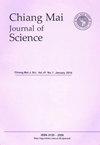Spatiotemporal Analysis of Ozone Concentration Using Semi-Functional Partial Linear Models
IF 0.8
4区 综合性期刊
Q3 MULTIDISCIPLINARY SCIENCES
引用次数: 0
Abstract
As weather warms up in China, ozone pollution rises to the top of the list of air pollutants. In this research, we examine the spatiotemporal variability of particulate matter components using contemporary functional data analysis techniques. The technique models the yearly pollutant profiles to describe their dynamic behavior over time and location. These cutting-edge methods offer dimension reduction for better data display and permit us to forecast annual profiles for locations and years for which data are lacking. In order to accurately estimate hourly ozone concentrations for 12 stations in China over two years (2015-2016), this study set out to showcase the best prediction models currently available. To accurately predict Ozone concentration, several methods are used, including Kernel Functional Classical Estimation (KFCE), Kernel Functional Quantile estimation (KFQE), Semi-Partial Linear Functional Classical Estimation (SPLFCE), Semi-Partial Linear Functional Quantile Estimation (SPLFQE), and Semi-Partial Linear Functional Expectile Estimation (SPLFEE). These functional models were chosen based on their ability to establish a forecast region with a given level of confidence. In terms of prediction accuracy, we may conclude that the Semi-Partial linear models outperform conventional models.利用半函数偏线性模型对臭氧浓度进行时空分析
随着中国天气转暖,臭氧污染上升到空气污染物的首位。在这项研究中,我们利用现代函数数据分析技术研究了颗粒物成分的时空变化。该技术对每年的污染物概况进行建模,以描述其随时间和地点变化的动态行为。这些先进的方法可以降低维度以更好地显示数据,并允许我们预测缺乏数据的地点和年份的年度概况。为了准确估算中国 12 个站点在两年内(2015-2016 年)的每小时臭氧浓度,本研究着手展示目前可用的最佳预测模型。为了准确预测臭氧浓度,研究采用了多种方法,包括核函数经典估计法(KFCE)、核函数量值估计法(KFQE)、半部分线性函数经典估计法(SPLFCE)、半部分线性函数量值估计法(SPLFQE)和半部分线性函数期望估计法(SPLFEE)。选择这些函数模型的依据是它们能够以给定的置信度建立预测区域。就预测精度而言,我们可以得出结论,半部分线性模型优于传统模型。
本文章由计算机程序翻译,如有差异,请以英文原文为准。
求助全文
约1分钟内获得全文
求助全文
来源期刊

Chiang Mai Journal of Science
MULTIDISCIPLINARY SCIENCES-
CiteScore
1.00
自引率
25.00%
发文量
103
审稿时长
3 months
期刊介绍:
The Chiang Mai Journal of Science is an international English language peer-reviewed journal which is published in open access electronic format 6 times a year in January, March, May, July, September and November by the Faculty of Science, Chiang Mai University. Manuscripts in most areas of science are welcomed except in areas such as agriculture, engineering and medical science which are outside the scope of the Journal. Currently, we focus on manuscripts in biology, chemistry, physics, materials science and environmental science. Papers in mathematics statistics and computer science are also included but should be of an applied nature rather than purely theoretical. Manuscripts describing experiments on humans or animals are required to provide proof that all experiments have been carried out according to the ethical regulations of the respective institutional and/or governmental authorities and this should be clearly stated in the manuscript itself. The Editor reserves the right to reject manuscripts that fail to do so.
 求助内容:
求助内容: 应助结果提醒方式:
应助结果提醒方式:


